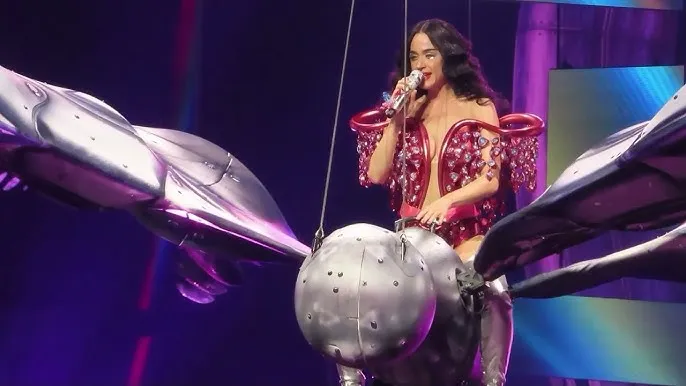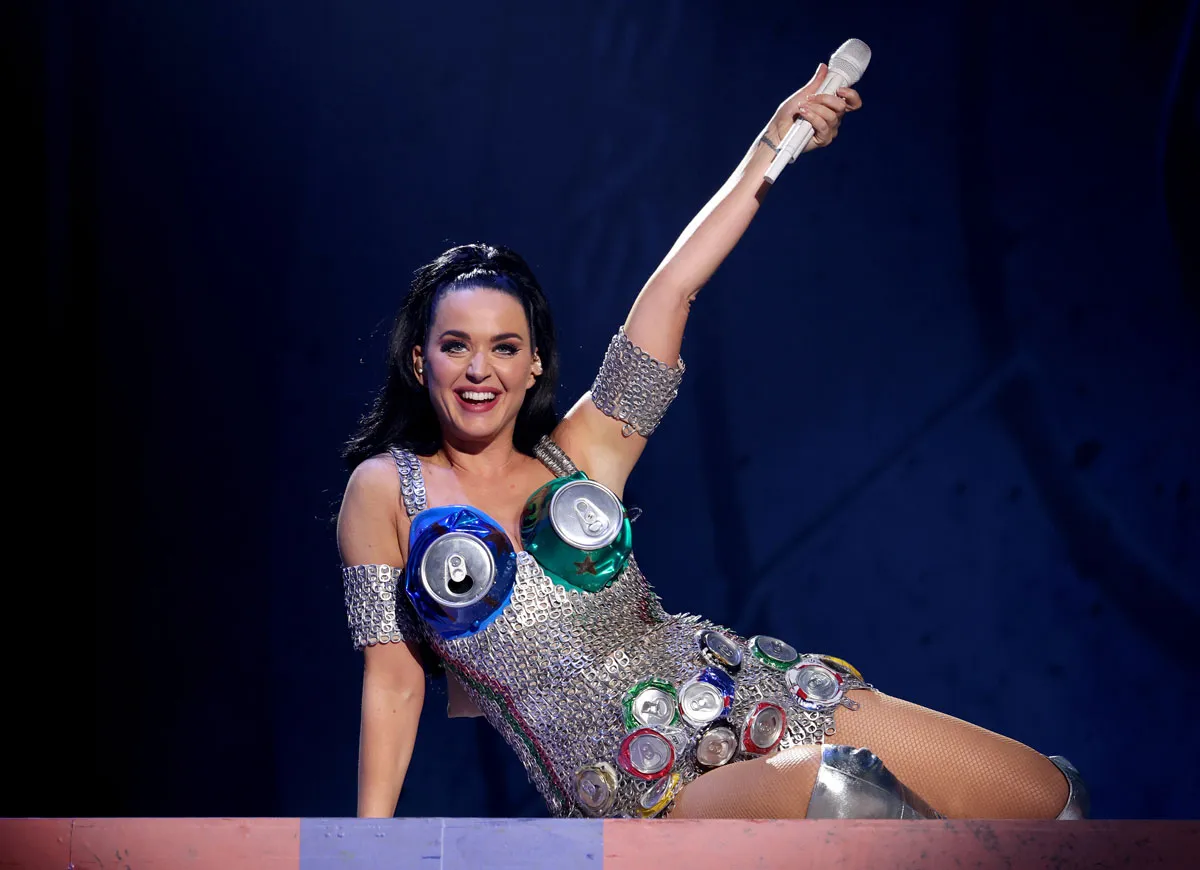

The technical team’s carelessness caused Katy Perry to face a dangerous incident on stage – Her current situation makes fans extremely worried
Katy Perry, the global pop superstar known for her colorful performances, iconic hits, and electrifying stage presence, recently experienced a frightening incident during her ongoing “Lifetimes Tour”. On the night of July 18 at Chase Center in San Francisco, a mechanical malfunction nearly sent Perry plummeting from a flying butterfly prop while performing her hit song “Roar.”
This shocking event has raised serious concerns about stage safety, technical oversight, and the potential risks performers face during large-scale tours. Fans around the world were left anxious and saddened, sharing clips and reactions on social media platforms like X (formerly Twitter), where the videos quickly went viral and racked up millions of views.
In this article, we’ll dive deep into the details of the incident, explore its broader context, discuss previous safety scares during the tour, and assess Katy Perry’s current condition and response to the event.
The Incident at San Francisco: A Close Call on Stage
During her performance at Chase Center, Katy Perry was suspended on a flying butterfly stage prop, a key part of her visually spectacular concert. Midway through her rendition of “Roar”, the rig suddenly experienced a technical glitch, causing the prop to falter and nearly drop Perry from a significant height.
Witnesses described a moment of sheer terror as the superstar dangled in mid-air before quickly regaining control. Remarkably, Perry continued her performance with her signature professionalism, demonstrating composure under extreme pressure.

Social media reactions were immediate: clips of the incident circulated widely, with millions expressing shock and concern. Many fans praised her quick thinking and bravery, while others criticized the tour’s technical team for what appeared to be negligence or insufficient safety precautions.
The Role of Technical Oversight: Could This Have Been Prevented?
Stage performances today involve complex props, pyrotechnics, and aerial rigs, requiring highly skilled technical crews to ensure safety. In Perry’s case, the malfunction of the flying butterfly raises questions about equipment maintenance, pre-show safety checks, and risk management protocols.
Industry experts emphasize that aerial stage props should be tested rigorously, with multiple fail-safes in place to prevent accidents. While Katy Perry’s composure prevented a serious injury, the incident highlights how even minor technical oversights can place performers in life-threatening situations.
Fans and critics alike have questioned whether the technical team adequately monitored the rig systems and whether this is indicative of broader safety concerns within high-budget concert tours.
Viral Reaction: Fans Express Fear and Concern
The incident quickly gained attention online, with fans flooding social media with reactions. Many expressed shock and anxiety, worrying about Perry’s safety and criticizing the technical team for the mishap. Hashtags related to the incident trended for days, and fan communities rallied around the singer, expressing relief that she was unharmed.
Some reactions highlighted the dangers inherent in live performances, emphasizing that pop stars often risk their lives for entertainment. Others celebrated Perry’s professionalism, noting that her ability to continue performing under duress reflects her years of experience and dedication.
The widespread sharing of videos on platforms like X, TikTok, and Instagram allowed fans globally to witness the incident firsthand, amplifying both concern and admiration.

Previous Incidents: A Pattern of Close Calls
The San Francisco incident is not the first time Perry faced dangerous moments during the Lifetimes Tour.
-
Adelaide, Australia – Early July: Katy Perry nearly fell from a giant cage-like stage prop. Fans were horrified, and footage from the concert circulated widely online.
-
Sydney, Australia – June: A TikTok creator rushed onto the stage and grabbed Perry’s shoulders while she performed, highlighting security vulnerabilities at large-scale concerts.
These repeated events underscore that, despite meticulous planning and high production value, live performances inherently carry risk. The incidents have sparked conversations about the need for better safety measures, stricter oversight, and improved risk assessment in touring operations.
The Lifetimes Tour: A High-Stakes Spectacle
Katy Perry’s Lifetimes Tour began on April 23 and is scheduled to continue through November, featuring elaborate stage designs, aerial stunts, and immersive visual effects. Despite the recent incidents, the tour remains highly popular among fans and media, with tickets selling rapidly and shows receiving widespread coverage.
The tour’s elaborate setup involves complex choreography, lighting, and props, which, while visually stunning, also increases the potential for accidents. Experts note that balancing entertainment spectacle with performer safety is one of the biggest challenges in modern pop tours.
Katy Perry’s Professionalism: Handling Danger With Grace
One of the most remarkable aspects of the San Francisco incident was Katy Perry’s professionalism under pressure. Despite nearly falling, she remained calm and composed, completing the performance without panic.
Fans and critics alike have praised her ability to focus amidst chaos, a skill honed through years of performing on massive stages worldwide. Perry’s reaction reflects her dedication to fans and her craft, ensuring the show continues regardless of unexpected challenges.
This incident has sparked broader discussions about the mental resilience required for high-profile performers, emphasizing that behind the glitz and glamour, there is immense pressure and responsibility.
Fan Concerns: Emotional Impact
The incident has had a significant emotional impact on Perry’s fanbase. Many have voiced concern for her well-being, expressing that repeated close calls make them fear for her safety. Fan forums and comment sections are filled with messages of support and worry, highlighting the strong connection between artists and their audiences.
Some fans have also criticized the tour’s management, suggesting that enhanced safety protocols and rigorous staff training are necessary to prevent future mishaps. The discussions underscore the delicate balance between artistic spectacle and performer safety.
Lessons from the Incident: Safety First in Live Performances
The mishap at San Francisco offers several key lessons for the live music industry:
-
Thorough Equipment Checks: All stage props, especially aerial rigs, must undergo strict safety testing.
-
Risk Management: Tour organizers must plan for emergencies and equip staff with protocols for rapid response.
-
Performer Awareness: Even the most experienced performers need clear communication about potential hazards.
-
Fan Education: Audiences should understand the complexity of modern stage shows while maintaining respect for performer safety.
By implementing these lessons, tours can minimize risk while delivering extraordinary entertainment, ensuring both performer and audience safety.
Katy Perry’s Current Status: Fans Breathe a Sigh of Relief
Fortunately, Katy Perry escaped the San Francisco incident unscathed. Following the event, she has been reported in good health and is continuing with her Lifetimes Tour schedule.

While the incident caused widespread concern, Perry’s resilience and determination reassure fans that she remains committed to delivering high-energy, visually stunning performances. However, the repeated incidents serve as a reminder of the potential dangers inherent in touring, especially for artists performing elaborate stunts.
The Future of the Lifetimes Tour: Balancing Safety and Spectacle
As the Lifetimes Tour progresses, questions remain about how future shows will address safety concerns. Experts suggest possible measures:
-
Upgrading aerial rigging and mechanical props
-
Increasing technical crew supervision during stunts
-
Enhancing security to prevent stage intrusions
-
Conducting more frequent risk assessments
By implementing stricter safety measures, the tour can continue to delight audiences without compromising performer safety. Katy Perry’s team faces the challenge of maintaining the visual spectacle that fans expect while protecting the artist from harm.
Conclusion: A Reminder of the Risks Behind the Glamour
Katy Perry’s near-fall during the Lifetimes Tour serves as a stark reminder that behind every dazzling performance lies potential danger. While the pop icon’s professionalism prevented injury, the incident has sparked conversations about technical oversight, performer safety, and fan concern.
As fans continue to support Perry, her experiences highlight the importance of safety-first planning in large-scale concerts, the dedication required from artists to entertain under risky conditions, and the emotional bond between performers and their audiences.
Katy Perry remains a shining example of resilience, skill, and commitment, proving that even in the face of danger, the show must go on.


















